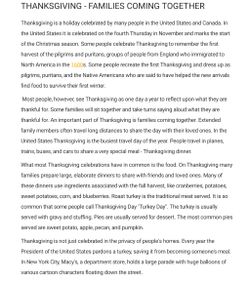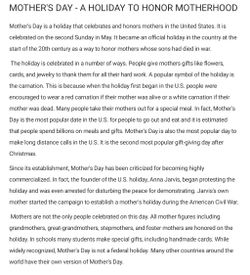Feb 19, 2022
Let's Practice Reading
Education
Education encompasses both the teaching and learning of knowledge, proper conduct, and technical competency. It thus focuses on the cultivation of skills, trades or professions, as well as mental, moral & aesthetic development.
Formal education consists of systematic instruction, teaching and training by professional teachers. This consists of the application of pedagogy and the development of curricula.
The right to education is a fundamental human right. Since 1952, Article 2 of the first Protocol to the European Convention on Human Rights obliges all signatory parties to guarantee the right to education. At world level, the United Nations' International Covenant on Economic, Social and Cultural Rights of 1966 guarantees this right under its Article 13.
Educational systems are established to provide education and training, often for children and the young. A curriculum defines what students should know, understand and be able to do as the result of education. A teaching profession delivers teaching which enables learning, and a system of policies, regulations, examinations, structures and funding enables teachers to teach to the best of their abilities. Sometimes educational systems can be used to promote doctrines or ideals as well as knowledge, which is known as social engineering. This can lead to political abuse of the system, particularly in totalitarian states and government.
Primary (or elementary) education consists of the first years of formal, structured education. In general, primary education consists of six or seven years of schooling starting at the age of 5 or 6, although this varies between, and sometimes within, countries. Globally, around 70% of primary-age children are enrolled in primary education, and this proportion is rising.
In most contemporary educational systems of the world, secondary education consists of the second years of formal education that occur during adolescence.It is characterized by transition from the typically compulsory, comprehensive primary education for minors, to the optional, selective tertiary, "post-secondary", or "higher" education (e.g., university, vocational school) for adults.
Higher education, also called tertiary, third stage, or post secondary education, is the non-compulsory educational level that follows the completion of a school providing a secondary education, such as a high school or secondary school. Tertiary education is normally taken to include undergraduate and postgraduate education, as well as vocational education and training. Colleges and universities are the main institutions that provide tertiary education. Collectively, these are sometimes known as tertiary institutions. Tertiary education generally results in the receipt of certificates, diplomas, or academic degrees.
How do dolphins sleep?
Since Dolphins are like human being in so many ways. For example, dolphins have a special respiratory just like humans. The only difference is that dolphins are able to stay underwater for a long time without breathing oxygen. But how do dolphins manage to sleep without drowning?
Generally, dolphins sleep with only one brain hemisphere in slow-wave sleep at a time, thus maintaining enough consciousness to breathe and to watch for possible predators and other threats. Earlier sleep stages can occur simultaneously in both hemispheres. In captivity, dolphins seemingly enter a fully asleep state where both eyes are closed and there is no response to mild external stimuli. In this case, respiration is automatic; a tail kick reflex keeps the blowhole above the water if necessary. Anesthetized dolphins initially show a tail kick reflex. Though a similar state has been observed with wild sperm whales, it is not known if dolphins in the wild reach this state. The Indus river dolphin has a sleep method that is different from that of other dolphin species. Living in water with strong currents and potentially dangerous floating debris, it must swim continuously to avoid injury. As a result, this species sleeps in very short bursts which last between 4 and 60 seconds.
HEMISPHERE hem·i·sphere /ˈheməˌsfir/ (noun)
THUS /T͟Həs/ (adverb) LITERARY•FORMAL
-as a result or consequence of this; therefore
ANESTHETIZE an·es·the·tize /əˈnesTHəˌtīz/ (verb)
past tense: anesthetized; past participle: anesthetized
STIMULUS stim·u·lus /ˈstimyələs/ (noun)
plural noun: stimuli
-a thing or event that evokes a specific functional reaction in an organ or tissue.











